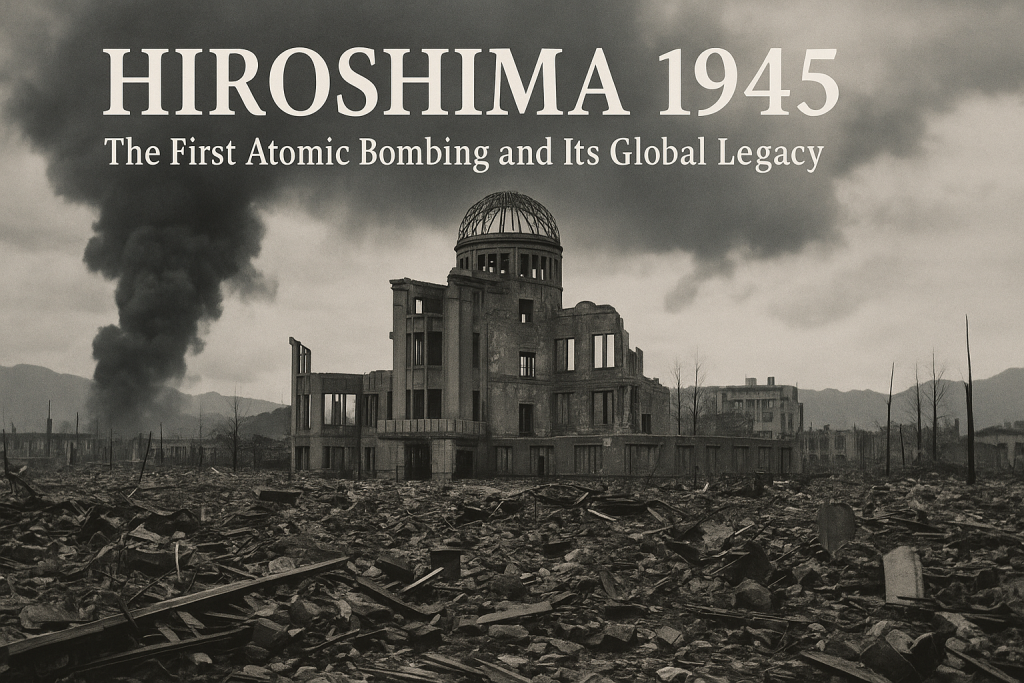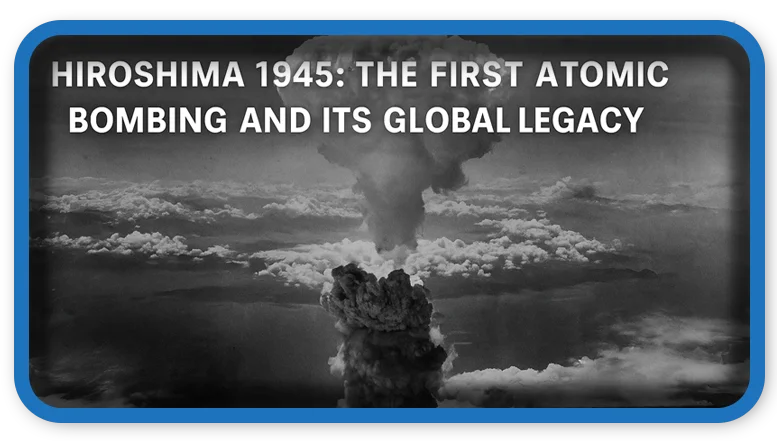⏲️ Estimated reading time: 5 min
Hiroshima 1945: The First Atomic Bombing and Its Global Legacy. On August 6, 1945, the U.S. dropped the first atomic bomb on Hiroshima, altering the course of history. This post explores the background, devastation, human toll, and ethical legacy of that fateful day.
The Day the World Changed: Hiroshima, August 6, 1945
At 8:15 a.m. local time on August 6, 1945, the American B-29 bomber Enola Gay released an atomic bomb nicknamed “Little Boy” over Hiroshima, Japan. Carrying 64 kg of highly enriched uranium-235, the bomb exploded approximately 600 meters above the city. As a result, it released an energy equivalent to 15,000 tons of TNT. It marked the first use of nuclear weapons in warfare and, consequently, changed human history forever.
Historical Background
By mid-1945, World War II had ended in Europe. However, fierce fighting continued in the Pacific. Japan showed no signs of surrender, and U.S. military leaders feared that a full-scale invasion would cost hundreds of thousands of lives on both sides. In response, the U.S. developed atomic weapons in secret under the Manhattan Project a three-year, $2 billion effort involving some of the world’s top scientists.
After Germany’s defeat, American focus shifted to Japan. U.S. leaders concluded that using the bomb might force a swift surrender, thereby avoiding a prolonged and bloody invasion.

Why Hiroshima Was Chosen
Hiroshima was not just a city it was a key military hub with a population between 350,000 and 400,000. Furthermore, unlike many other Japanese cities, it had been spared from earlier bombings. This made it an ideal site to measure the atomic bomb’s full destructive capability. Additionally, its flat terrain and dense population increased the potential impact. Weather conditions on the morning of August 6 were also favorable, which further supported the mission’s success.
The Blast and Its Devastation
Once released, the uranium bomb detonated with catastrophic force. Temperatures near the blast center soared to several hundred thousand degrees Celsius. Consequently, everything within a one-kilometer radius was either vaporized or flattened. A shock wave radiated outward, followed by a massive firestorm. Thermal radiation ignited fires across the city, and skin burns occurred as far as two kilometers away from ground zero.
Moreover, buildings crumbled, steel melted, and glass turned into deadly shards. Hiroshima was engulfed in chaos within seconds.
Human Cost and Lingering Suffering
Between 70,000 and 80,000 people died instantly many of them civilians. In the following days and weeks, thousands more died from burns, internal injuries, and acute radiation sickness. Survivors, known as hibakusha, faced not only physical trauma but also lifelong health complications and social stigma.
In addition, long-term effects included chronic illnesses like leukemia and various cancers. Some feared genetic damage would affect future generations. However, scientific studies have found limited evidence of widespread hereditary mutations.
Nagasaki and Japan’s Surrender
Just three days later, on August 9, a second atomic bomb “Fat Man” was dropped on Nagasaki. This resulted in another estimated 40,000 deaths. Faced with the threat of more atomic attacks and the Soviet Union’s entry into the war, Emperor Hirohito finally announced Japan’s unconditional surrender on August 15. Subsequently, the formal signing occurred aboard the USS Missouri on September 2, officially ending World War II.

Aftermath and Rebuilding Hiroshima
In the years following the bombing, Hiroshima struggled with radioactive contamination. Nevertheless, the city was gradually rebuilt. The Japanese government, along with international scientists, continued to study the genetic and environmental consequences among survivors and their descendants.
Today, Hiroshima stands as a symbol of peace and recovery. The Hiroshima Peace Memorial Park, built around the remains of the Prefectural Industrial Promotion Hall (now called the Atomic Bomb Dome), serves as a poignant reminder. Moreover, the site now a UNESCO World Heritage Site hosts the annual Peace Memorial Ceremony, drawing global visitors and dignitaries.
Global Impact and Nuclear Legacy
The bombings ushered in the nuclear age. The Cold War arms race soon followed, with the U.S. and Soviet Union amassing massive nuclear arsenals. But they also sparked global anti-nuclear movements and led to key treaties such as the NPT (Non-Proliferation Treaty) and CTBT (Comprehensive Nuclear-Test-Ban Treaty), aimed at preventing further use and spread of nuclear weapons.
The ethical debate over the bombings remains unresolved. Were they necessary to end the war or moral catastrophes that targeted civilians? The arguments persist, but the need for caution in wielding nuclear technology is universally recognized.
Conclusion
The atomic bombing of Hiroshima was a decisive act that ended one of history’s deadliest wars but at a tremendous human cost. Today, Hiroshima symbolizes both destruction and rebirth, science’s dual nature, and the enduring call for peace. Its legacy challenges the world to never again unleash such devastation.
📩 Do you have questions or suggestions? Leave a comment or contact us!
🏷️ Tags: Hiroshima, World War II, Atomic Bomb, Enola Gay, Little Boy, Manhattan Project, Nuclear Weapons, Peace Memorial, Japan History, Hibakusha
Only logged-in users can submit reports.
Discover more from HelpZone
Subscribe to get the latest posts sent to your email.

